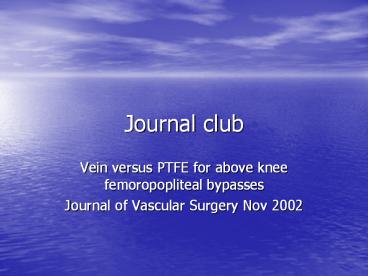Journal club - PowerPoint PPT Presentation
1 / 29
Title: Journal club
1
Journal club
- Vein versus PTFE for above knee femoropopliteal
bypasses - Journal of Vascular Surgery Nov 2002
2
Long held view that results are equivalent
- Only a few randomized trials in the literature
- Amazing that at time of recruitment 1993, only 1
other trial to compare to.
3
PTFE perceived advantages
- Faster
- Preserved the vein for other reconstructions -
CABG, Femoral bypasses
4
Past assumptions
- Patency not an issue
- Infection while prosthetic infection is worse
the low rates of graft infection meant that
statistically it should not matter unless very
large numbers were compared.
5
Things that change
- Movement away from LSV for CABG, now IMA and
radial arteries are preferred. - Sequential techniques that reduce the amount of
conduit required - Reduction in amount of CABG due to drug eluting
stents.
6
Things that change
- Graft surveillance scanning.
- The improves the patency of vein bypasses but not
of PTFE. - Different methods
- Serial resting ABIs
- Exercise ABIs
- Full duplex study
7
Things that do not change
- It is the reverse that is more relevant to the
bulk of patients - As CABG occurs in a different set of patients and
generally about 10 years earlier the question is
can the vein be left for us. - If the LSV is harvested, it is taken from the
ankle up. This allows for sizing to the small
coronary
8
The study
- Looks good
- Presumed single centre
- Randomized
- 75 and 76 in the groups
9
Randomization
- Only if the AK popliteal was suitable and the
vein was good did randomization occur. Begs the
question how they did this without making long
incisions.
10
Surgical technique
- All vein bypasses were reversed, no insitus.
- Uniform technique.
11
Surveillance
- Haemodynamic profile ABI and velocity profile
of the vessels above and below the bypass. - This is not our standard.
12
Cohorts
- More diabetics in the PTFE group
- However run off scores were similar.
13
The key endpoints
14
Patency
- Better for vein
- The differences only showing up after 2 years.
- Both primary
- Vein 75 vs PTFE 52
- And secondary patency
- Vein 80 and PTFE 58
15
Patency
- In comparison with other series the differences
are more marked as the PVD worsens. - 4 year patency was 61 vs. 38 and 75 vs. 50 in
those series with higher proportions of critical
ischaemic in the cohorts. Veith 1986, Johnson
2000.
16
Patency
- In claudicants the patency is much closer.
- In the one trial with only claudicants in it
patency at 6 years was not significantly
different. Abdu Rhama 1999 Surgery
17
Patency vs. Mortality
- After 5 years 38 of the patients had died.
- Previously it has been established that patients
with critical ischaemia are fragile. - Claudicants have a much better outlook.
18
Was the vein needed for CABG?
- No.
- Only 2 of the 76 PTFE underwent CABG and the vein
was not used anyway. - Only 1 of 75 in the vein group and the distal
vein was available and taken.
19
If the vein was spared was it used later?
- Mystery here
- Of the 29 failed prosthetic bypasses 16 had redo
ops - 13 went below the knee, yet only 3 of these used
vein ! - The authors do not specify why. This is a key
question.
20
Why not use the vein at re-operation
- Either
- It had been damaged at the original operation.
- Was overlooked.
21
What are the consequences of graft occlusion
- Held that prosthetic occlusions are often more
serious as they take out the run off - Here if a graft occluded and it was more than 7
days then a wait and see approach was used. - Only 24 of the cohort had critical ischaemia to
begin with.
22
Prosthetic
- If the 29 PTFE occlusions 16 went back i.e. more
than half. - This you would not expect if only ¼ were
critically ischaemic pre op. - The mandatory take back if with 7 days may have
swelled this figure.
23
Vein
- Of the 14 vein occlusions only 5 went back.
- This is more expected.
24
What could explain these differences?
- The occlusion of the PTFE graft does sacrifice
run off. - The authors suggest that PTFE grafts may promote
distal atheroma. I dont like this. - They imply this as more patients went back and
then the grafts were taken more distally.
25
Why the difference.
- The decision to go below knee is easier to make
if you have unlimited conduit fresh tissue
planes etc. - May have been more likely to accept a diseased AK
pop with a short vein.
26
Limb loss
- 2 amputations in the venous group
- Had redo venous bypasses block, then redo PTFE
distal bypasses block then limb loss.
27
Limb Loss
- 2 amputations in prosthetic gp
- Both after failed PTFE distal bypasses
- Both groups similar
28
Conclusions
- Use the vein first
- Better patency
- Lower risk of re-intervention
- Re-intervention tends to be more proximal
- The LSV is unlikely to be needed elsewhere
especially CABG
29
Conclusions
- Vascular patients die
- In those with high operative risk and short life
expectancy then a prosthetic graft works well for
2 years. - Reasonable second line conduit especially in
claudicants.































